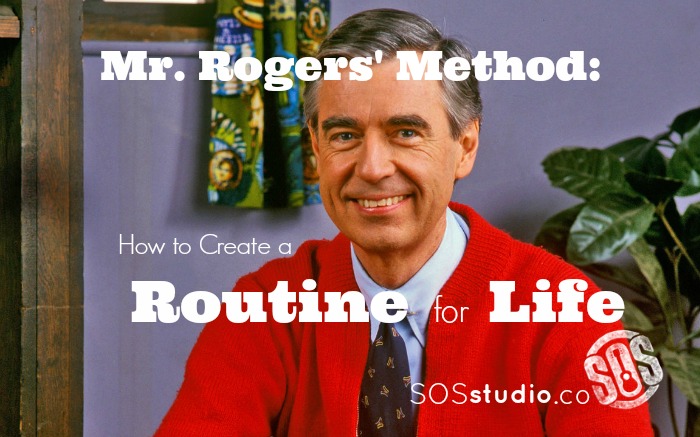
Over 31 years, Fred Rogers recorded 865 shows of Mr. Rogers’ Neighborhood. Out of those 865 shows, he performed the exact same routine 865 times. A routine that prepared him for his time to make believe. He was setting a precedent for all his young fans that structuring one’s day will lead to better creativity and self-improvement; that building a framework allows for one to effortlessly flow between work time and play time. Here’s how Mr. Roger’s Method was structured and how it can help artists compartmentalize their time and create a routine in order to maximize their creativity.
Mr. Rogers’ Routine
So what was this miracle pattern he repeated? Was it something intricate only he could perform? Of course not. EVERY day (while singing) he’d…
- Walk through the door
- Take off his jacket and put on his sweater
- Sit down, take off his shoes
- And put on sneakers
Why this was brilliant
 Mr. Rogers once visited Koko, the female gorilla who communicates through American Sign Language. She was such a fan of his show that she took him in her arms, signed “I Love You” and started taking off his shoes. His simple gesture of repeating a ritual had resonated so profoundly with her that she had associated it with the entirety of his character. His actions were no longer personal rituals, they were now visual calling cards that embedded his beliefs in the mind of his viewers.
Mr. Rogers once visited Koko, the female gorilla who communicates through American Sign Language. She was such a fan of his show that she took him in her arms, signed “I Love You” and started taking off his shoes. His simple gesture of repeating a ritual had resonated so profoundly with her that she had associated it with the entirety of his character. His actions were no longer personal rituals, they were now visual calling cards that embedded his beliefs in the mind of his viewers.
This phenomenon was not just something attributed solely to his on-camera character. Fred led a very structured lifestyle: waking up every morning at 5:30am to his morning routine of reading, writing, and meditation; taking a mid-afternoon nap; and going to bed at 9:30 every night to enjoy 8 hours of uninterrupted sleep.
Obviously, the discipline with which Mr. Rogers structured his entire life, not just the persona we saw on screen, will not work for everyone. But here are the key components to building his ritual that you may implement into your own.
How to create a routine
- Plan Ahead. Block out chunks of your day for when you want to work, create, play, whatever it is that you need help setting a routine for. Put that down in whatever calendar you use weeks, months, or even years ahead so that there is no last-minute attempt to plan (or forget) time to be productive. (Side note: if you’re not currently using a calendar, GO BUY ONE. Or start using the calendar app on your phone.)
- Be Simple. Don’t sit down and plan a whole process on paper. Instead, think about what you do normally to prepare yourself for work and then simplify that into a repeatable pattern. For instance, if you’re not already planning racquetball for an hour every morning, don’t add it in now because that will set you back a step in establishing your routine. Start with what you have, simplify it, then plan ahead to adjust your routine using your calendar.
- Use Visual Cues. When dogs have separation anxiety, the best treatment is perform a routine when you leave the house, such as: shoes, keys, lights, door. If you perform that routine the exact same way every time, the dog knows that you will come back and that she can rest. Provide visual cues for yourself such as setting out your notepad and water bottle in the same place every time, adjusting the lighting in your room, or always sitting in the same chair.
- Physical Reminders. Physical actions are the fastest way for your body to remember something. (and odors, but that’s a whole different story.) “Muscle memory” is not just a term that actors and hippies use, it is a phenomenon that allows your body to recall prior circumstances when placed in similar positions. With Mr. Rogers, he always opened the closet to get his sweater, and always sat down to put on his shoes. Those are physical actions that don’t have to be in his ritual but are there to provide more cues to his body (and thus mind) that he is getting ready to work. Tip: try starting your routine with a 2-minute plank every time, breathing through your nose. This will engage your core, fire up your brain, and tell your body it’s time to be productive.
Implementing into your daily life
As Mr. Rogers taught all of his viewers, the key to achieving better creativity and self-improvement is by providing a play space for your mind to explore. The more planning, simplification, visual cues, and physical reminders incorporated into your ritual, the faster your body will acclimate and claim it as the norm. Bonus points if you can figure out how to incorporate puppets into your routine…
Dear Reader: Do you have rituals in place to get your ready to create? What happens if you change it, even if just slightly?
